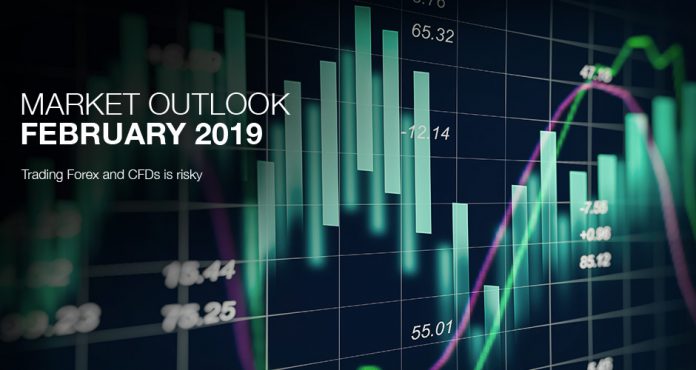The overall performance of the US economy in January, including the longest-running government shutdown ever, was supportive of economists’ prospects for a slowdown in 2019.
Click the button below for a FREE copy of our Monthly insights for February 2019 and get an overview of some of the key events for the month ahead.
CLICK HERE FOR THE .PDF VERSION OF THE OUTLOOK
CURRENCIES
Dollar: The Dollar made large moves against the Euro in January, with the overall movement resulting in the pair averaging at about 1.14 during the month, as the overall performance of the US economy, including the longest-running government shutdown ever, was supportive for economists’ prospects for a slowdown in 2019. A Reuters survey of economists suggests that they still expect two rate hikes in 2019 even though 30-day Fed Fund futures suggest that markets expect just one hike. February starts off with the NFP release on the 1st, with inflation, retail sales and FOMC minutes coming up on the 13th, 15th, and 20th respectively. Importantly, the 2018 Q4 preliminary GDP numbers are expected to come out on the 28th of February.
Euro: Developments in the Euro have been less positive than expected and focus on two pillars: the first relates to expectations on lower Euro Area economic growth as a result of international developments, while the second relates to Brexit, whose deadline is fast approaching. February should be a relatively low key policy month as no meetings are expected to take place, with economic announcements dominated by 2018 Q4 GDP results on the 14th and inflation on the 22nd.
Sterling: January has been a positive month for the Sterling as it rallied against both the Euro and the Dollar, on anticipation of developments in the Brexit issue and after discounting Parliament’s rejection of Theresa May’s plan. Brexit will again dominate the headlines for Sterling as May was ordered to renegotiate the Brexit deal. The next BoE meeting on the 7th of February stands out from the calendar, while GDP, inflation, and earnings come out on the 12th, 13th, and 19th respectively.
Yen: The Japanese currency traded relatively stable against the Dollar, broadly maintaining its December gains, as worse than expected trade performance was countered by improvements in inflation and retail trade. Trade balance on the 20th is expected to be the major currency mover next month, along with inflation on the 22nd and retail trade on the 28th.
Aussie: The Aussie has managed to retain its early-January gains against the Dollar, despite the continued worsening of the housing sector and negative loans growth. In February, the month starts with the Trade Balance on the 5th, with the interest rate decision on the 8th not expected to register any change for the time being.
Loonie: Similar to the Yen and the Aussie, the Loonie managed to maintain its gains against the Dollar, after a relatively better than expected macroeconomic performance. Retail Sales on the 22nd and inflation on the 27th are the most important events of the month.
Emerging: The Ruble gained against the Dollar in January, mostly on account of the large interest rate differential between the two countries. A similar path was observed for the ZAR which continued to gain against the Dollar. The Peso gained some more with respect to the Dollar in the early days of the year but then stabilized around the 19 mark. On the other hand, the Turkish Lira traded flat over the month, stabilizing at levels higher than last year, pushing the economy into an inflationary spiral.
COMMODITIES
Gold: The world’s favourite yellow metal gained significantly in January, as the Fed chairman talked more dovishly than expected and pushed the Dollar down. Gold bounced above the 1300 mark, gaining 7.6% since November and ignoring the rise in the US 10-year bond yield, while the overall bullish performance of the USA500 did not appear to have any negative effect on the metal. As the central banks around the world shift to keeping interest rates stable, Gold may be able to retain its gains, even though the easing of Brexit and trade war tensions could potentially have a negative effect.
Silver: The price of Silver continued its upwards movement in January after a strong rally in late December, despite a short down movement in the middle of the month. The metal, following Gold’s path, gained 12.5% since the end of November and, if its price can be considered a foreteller of global market concerns and risks, Silver is up for a very volatile year in 2019.
Oil: Oil gained significantly in January after registering a low of $44 in December. The rally ended after the first 10 days of the month, after which Oil managed to maintain its gains and trade around the $52-53 mark. Regarding supply, OPEC+ agreed to further cut production in February, while the effects from the political crisis in Venezuela and the extent of US supply growth are still uncertain.
INDICES
US: The long bearish sentiment which prevailed in the markets since early October appears to have at least eased, as markets have been gaining since the last days of December and stabilizing in the last days of January, across all three indices (US30, US100, and US500). A definite policy stance from Powell would assist in gauging the direction of the market, as dovish comments, along with delayed rate hikes should be beneficial to the economy. Still, as the trade war with China continues, higher spending can be eroded by higher inflation as prices and production costs rise. US companies with China exposure are also expected to be hurt if the country experiences the long-awaited slowdown.
Europe: Stock markets in Europe moved quite idiosyncratically in January. Affected by the rejection of the Brexit agreement and the overall uncertainty prevailing as the deadline approaches, the UK100 rose by much less than the GER30 which has recorded a strong upwards trend since the beginning of the month, rising by 7.3% over the month. The EUR50 moved along the lines of Germany’s stock market performance, gaining 7% over the month. The notable difference between European and US Indices is that the latter appear to have stabilized in late January, supporting the view of a US slowdown and the effect of the China trade tariffs.
CRYPTOS
Bitcoin: Following a three-month low volatility regime, and its large drop in the last two months of the year which wiped out 54% of the crypto’s value to date, Bitcoin managed to hold its late-December gains for the first days of the year, after which it dropped below the $4000 mark. The current price stands below even the $3500 mark, as the future of Bitcoin appears to be uncertain, given the absence of fundamentals to price its value upon. As expected, its future will be heavily affected by sovereign regulations on its operations, demand for private transactions, and any potential security threats. Still, the announcement of new coin issues supports the view that cryptos are here to say, at least in the near future.
Ripple’s price was affected by the Bitcoin drop, albeit to a smaller extent given that, at least in theory, it should be more independent than its peers due to its centralized nature. Ripple’s price declined to USD0.26, registering a 48% decline. A similar path was observed for Ethereum and Litecoin, which declined by 49.8% and 56.6% respectively with the latter following Bitcoin’s price behaviour. Similar to our earlier monthly outlooks, we would like to underline that the three Cryptos cannot avoid following the Bitcoin path, at least in the near future, as evidenced by their recent behaviour.
BONDS
US10Year: Expectations for a slowdown in US economic growth pushed US government yields higher in January, with the majority of the effect taking place at the beginning of the year. This development was also aided by the trade tensions and the overall uncertainty in the US economy and despite the stock market rise during the month. However, if the Fed commits to raising rates twice in 2019 more upward pressure should be put on the yield.
UK Gilt: Yields on the UK Gilt increased in January, as markets anticipated the rejection of the Brexit proposal. Despite upwards pressure, yields appear to have stabilized around their beginning of the month values, as uncertainty about the final outcome of the Brexit agreement remains as the deadline nears. In the case that a Brexit deal is reached, bond yields should increase as BoE is expected to step up its rate hike schedule.
EUBund: The Bund yield increased in the beginning of the year, with significant volatility registered, as Brexit and trade tension uncertainty took its toll on the bond. Most importantly, the end of QE in the December ECB meeting put some upwards pressure on the yield, as predicted in our November market outlook. Furthermore, an anticipation of rate hikes in Fall 2019 could also put upwards pressure on the yield.
*All data and references for the above were obtained from the following sources (unless otherwise specified): Analysis (various articles), Economic Calendar, and the MT4 platform.
Click here to access the Economic calendar
Dr Nektarios Michail
Market Analyst
Disclaimer: This material is provided as a general marketing communication for information purposes only and does not constitute an independent investment research. Nothing in this communication contains, or should be considered as containing, an investment advice or an investment recommendation or a solicitation for the purpose of buying or selling of any financial instrument. All information provided is gathered from reputable sources and any information containing an indication of past performance is not a guarantee or reliable indicator of future performance. Users acknowledge that any investment in FX and CFDs products is characterized by a certain degree of uncertainty and that any investment of this nature involves a high level of risk for which the users are solely responsible and liable. We assume no liability for any loss arising from any investment made based on the information provided in this communication. This communication must not be reproduced or further distributed without our prior written permission.



















